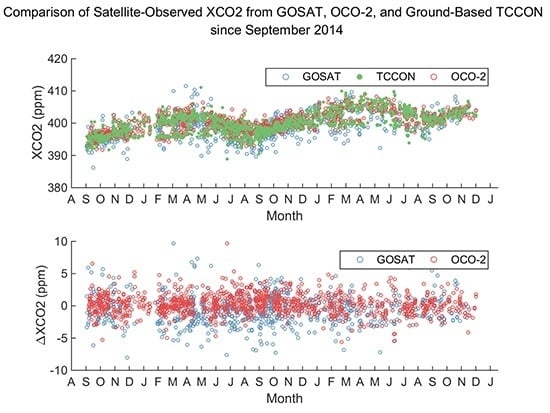Comparison of Satellite-Observed XCO2 from GOSAT, OCO-2, and Ground-Based TCCON
Abstract
:1. Introduction
2. Materials and Methods
2.1. GOSAT
2.2. OCO-2
2.3. TCCON
2.4. Method
3. Results and Discussion
3.1. Validation of XCO2 from Satellites with TCCON Data
3.2. Comparison of XCO2 Data between GOSAT and OCO-2
4. Conclusions
Acknowledgments
Author Contributions
Conflicts of Interest
References
- Kuze, A.; Suto, H.; Nakajima, M.; Hamazaki, T. Thermal and near infrared sensor for carbon observation fourier-transform spectrometer on the Greenhouse Gases Observing Satellite for greenhouse gases monitoring. Appl. Opt. 2009, 48, 6716–6733. [Google Scholar] [CrossRef] [PubMed]
- Crisp, D.; Atlas, R.M.; Breon, F.M.; Brown, L.R.; Burrows, J.P.; Ciais, P.; Connor, B.J.; Doney, S.C.; Fung, I.Y.; Jacob, D.J.; et al. The Orbiting Carbon Observatory (OCO) mission. Adv. Space Res. 2004, 34, 700–709. [Google Scholar] [CrossRef]
- Hammerling, D.M.; Michalak, A.M.; Kawa, S.R. Mapping of CO2 at high spatiotemporal resolution using satellite observations: Global distributions from OCO-2. J. Geophys. Res. Atmos. 2012, 117. [Google Scholar] [CrossRef]
- Liao, M. Long duo rocket successfully launched china’s first carbon satellite. China Aerosp. 2017, 21. [Google Scholar]
- Han, G.; Ma, X.; Liang, A.; Zhang, T.; Zhao, Y.; Zhang, M.; Gong, W. Performance Evaluation for China’s Planned CO2-IPDA. Remote Sens. 2017, 9, 768. [Google Scholar] [CrossRef]
- Guerlet, S.; Butz, A.; Schepers, D.; Basu, S.; Hasekamp, O.P.; Kuze, A.; Yokota, T.; Blavier, J.F.; Deutscher, N.M.; Griffith, D.W.T. Impact of aerosol and thin cirrus on retrieving and validating XCO2 from GOSAT shortwave infrared measurements. J. Geophys. Res. Atmos. 2013, 118, 4887–4905. [Google Scholar] [CrossRef]
- Yoshida, J.; Kuze, A.; Suto, H.; Shiomi, K.; Fukagawa, S.; Nakajima, M. GOSAT/TANSO Level 1 Algorithms—Toward 1ppm Accuracy of XCO2 from a Space-borne FTS. In Fourier Transform Spectroscopy; Optical Society of America: Washington, DC, USA, 2013. [Google Scholar]
- Parker, R.; Boesch, H.; Somkuti, P.; Palmer, P.; Feng, L.; Bergamaschi, P.; Chevallier, F. Assessing 5 years of GOSAT Proxy XCH4 data and associated uncertainties. Atmos. Meas. Tech. Discuss. 2015, 8, 5937–5972. [Google Scholar] [CrossRef]
- Kikuchi, N.; Yoshida, Y.; Uchino, O.; Morino, I.; Yokota, T. An advanced retrieval algorithm for greenhouse gases using polarization information measured by GOSAT TANSO-FTS SWIR I: Simulation study. J. Geophys. Res. Atmos. 2016, 121. [Google Scholar] [CrossRef]
- Morino, I.; Uchino, O.; Inoue, M.; Yoshida, Y.; Yokota, T.; Wennberg, P.O.; Toon, G.C.; Wunch, D.; Roehl, C.M.; Notholt, J.; et al. Preliminary validation of column-averaged volume mixing ratios of carbon dioxide and methane retrieved from GOSAT short-wavelength infrared spectra. Atmos. Meas. Tech. 2011, 4, 1061–1076. [Google Scholar] [CrossRef]
- Wunch, D.; Wennberg, P.O.; Toon, G.C.; Connor, B.J. A method for evaluating bias in global measurements of CO2 total columns from space. Atmos. Chem. Phys. Discuss. 2011, 11, 12317–12337. [Google Scholar] [CrossRef]
- O’Dell, C.W.; Connor, B.; Bösch, H.; O’Brien, D.; Frankenberg, C.; Castano, R.; Christi, M.; Eldering, D.; Fisher, B.; Gunson, M.; et al. The ACOS CO2 retrieval algorithm—Part 1: Description and validation against synthetic observations. Atmos. Meas. Tech. 2012, 5, 99–121. [Google Scholar] [CrossRef]
- Cogan, A.J.; Boesch, H.; Parker, R.J.; Feng, L.; Palmer, P.I.; Blavier, J.F.L.; Deutscher, N.M.; Macatangay, R.; Notholt, J.; Roehl, C.; et al. Atmospheric carbon dioxide retrieved from The Greenhouse gases Observing Satellite (GOSAT): Comparison with ground-based TCCON observations and GEOS-Chem model calculations. J. Geophys. Res. Atmos. 2012, 117. [Google Scholar] [CrossRef]
- Crisp, D.; Fisher, B.M.; O’Dell, C.; Frankenberg, C.; Basilio, R.; Bösch, H.; Brown, L.R.; Castano, R.; Connor, B.; Deutscher, N.M.; et al. The ACOS CO2 retrieval algorithm—Part II: Global XCO2 data characterization. Atmos. Meas. Tech. 2012, 5, 687–707. [Google Scholar] [CrossRef]
- Yoshida, Y.; Kikuchi, N.; Morino, I.; Uchino, O. Improvement of the retrieval algorithm for GOSAT SWIR XCO2 and XCH4 and their validation using TCCON data. Atmos. Meas. Tech. 2013, 6, 1533–1547. [Google Scholar] [CrossRef]
- Jiang, H. Comparison analysis of the global carbon dioxide concentration column derived from SCIAMACHY, AIRS, and GOSAT with surface station measurements. Int. J. Remote Sens. 2015, 36, 1406–1423. [Google Scholar]
- Zhou, M.; Dils, B.; Wang, P.; Detmers, R.G.; Yoshida, Y.; O’Dell, C.W.; Feist, D.G.; Velazco, V.; Schneider, M.; De Mazière, M. Validation of TANSO-FTS/GOSAT XCO2 and XCH4 glint mode retrievals using TCCON data from near-ocean sites. Atmos. Meas. Tech. 2016, 9, 1415–1430. [Google Scholar] [CrossRef]
- Jiang, X.; Crisp, D.; Olsen, E.T.; Kulawik, S.S.; Miller, C.E.; Pagano, T.S.; Liang, M.; Yung, Y.L. CO2 annual and semiannual cycles from multiple satellite retrievals and models. Earth Space Sci. 2016, 3, 78–87. [Google Scholar] [CrossRef]
- Bovensmann, H.; Burrows, J.P.; Buchwitz, M.; Frerick, J.; Noel, S.; Rozanov, V.; Chance, K.; Goede, A.P.H. SCIAMACHY: Mission objectives and measurement modes. J. Atmos. Sci. 1999, 56, 125–150. [Google Scholar] [CrossRef]
- Buchwitz, M.; Schneising, O.; Burrows, J.P.; Bovensmann, H.; Notholt, J. First direct observation of the atmospheric CO2 year-to-year increase from space. Atmos. Chem. Phys. 2007, 7, 4249–4256. [Google Scholar] [CrossRef]
- Yokota, T.; Yoshida, Y.; Eguchi, N.; Ota, Y.; Tanaka, T.; Watanabe, H.; Maksyutov, S. Global concentrations of CO2 and CH4 retrieved from GOSAT: First preliminary results. Sci. Online Lett. Atmos. Sola 2009, 5, 160–163. [Google Scholar] [CrossRef]
- Rayner, P.; O’Brien, D. The utility of remotely sensed CO2 concentration data in surface source inversions. Geophys. Res. Lett. 2001, 28, 175–178. [Google Scholar] [CrossRef]
- Frankenberg, C.; Pollock, R.; Lee, R.A.M.; Rosenberg, R.; Blavier, J.F.; Crisp, D.; O’Dell, C.W.; Osterman, G.B.; Roehl, C.; Wennberg, P.O. The Orbiting Carbon Observatory (OCO-2): Spectrometer performance evaluation using pre-launch direct sun measurements. Atmos. Meas. Tech. 2015, 7, 301–313. [Google Scholar] [CrossRef]
- Eldering, A.; O’Dell, C.W.; Wennberg, P.O.; Crisp, D.; Gunson, M.R.; Viatte, C.; Avis, C.; Braverman, A.; Castano, R.; Chang, A.; et al. The Orbiting Carbon Observatory-2: First 18 months of science data products. Atmos. Meas. Tech. 2017, 10, 549–563. [Google Scholar] [CrossRef]
- Wunch, D.; Wennberg, P.O.; Osterman, G.; Fisher, B.; Naylor, B.; Roehl, C.M.; O’Dell, C.; Mandrake, L.; Viatte, C.; et al. Comparisons of the Orbiting Carbon Observatory-2 (OCO-2) XCO2 measurements with TCCON. Atmos. Meas. Tech. Discuss. 2017, 10, 2209–2238. [Google Scholar] [CrossRef]
- Kort, E.A.; Patra, P.K.; Ishijima, K.; Daube, B.C.; Jiménez, R.; Elkins, J.; Hurst, D.; Moore, F.L.; Sweeney, C.; Wofsy, S.C. Tropospheric distribution and variability of N2O: Evidence for strong tropical emissions. Geophys. Res. Lett. 2011, 38, L15806. [Google Scholar] [CrossRef]
- Turner, A.J.; Jacob, D.J.; Wecht, K.J.; Maasakkers, J.D.; Lundgren, E.; Andrews, A.E.; Biraud, S.C.; Boesch, H.; Bowman, K.W.; Deutscher, N.M. Estimating global and north american methane emissions with high spatial resolution using GOSAT satellite data. Atmos. Chem. Phys. 2015, 15, 4495–4536. [Google Scholar] [CrossRef]
- Liang, A.; Han, G.; Gong, W.; Yang, J.; Xiang, C. Comparison of global XCO2 concentrations from OCO-2 with TCCON data in terms of latitude zones. IEEE J. Sel. Top. Appl. Earth Obs. Remote Sens. 2017, 10, 2491–2498. [Google Scholar] [CrossRef]
- Wunch, D.; Toon, G.C.; Blavier, J.-F.L.; Washenfelder, R.A.; Notholt, J.; Connor, B.J.; Griffith, D.W.T.; Sherlock, V.; Wennberg, P.O. The total carbon column observing network. Philos. Trans. R. Soc. Lond. A Math. Phys. Eng. Sci. 2011, 369, 2087–2112. [Google Scholar] [CrossRef] [PubMed]
- Feist, D.G.; Arnold, S.G.; John, N.; Geibel, M.C. TCCON Data from Ascension Island, Saint Helena, Ascension and Tristan da Cunha, Release ggg2014r0. TCCON Data Archive, Hosted by the Carbon Dioxide Information Analysis Center, Oak Ridge National Laboratory, Oak Ridge, TN, USA. 2014. Available online: http://dx.doi.org/10.14291/tccon.ggg2014.ascension01.R0/1149285 (accessed on 1 April 2017).
- Deutscher, N.; Notholt, J.; Messerschmidt, J.; Weinzierl, C.; Warneke, T.; Petri, C.; Grupe, P.; Katrynski, K. TCCON Data from Bialystok, Poland, Release ggg2014r1. TCCON Data Archive, Hosted by the Carbon Dioxide Information Analysis Center, Oak Ridge National Laboratory, Oak Ridge, TN, USA. 2014. Available online: http://dx.doi.org/10.14291/tccon.ggg2014.bialystok01.R1/1183984 (accessed on 1 April 2017).
- Notholt, J.; Petri, C.; Warneke, T.; Deutscher, N.; Buschmann, M.; Weinzierl, C.; Macatangay, R.; Grupe, P. TCCON Data from Bremen, Germany, Release ggg2014r0. TCCON Data Archive, Hosted by the Carbon Dioxide Information Analysis Center, Oak Ridge National Laboratory, Oak Ridge, TN, USA. 2014. Available online: http://dx.doi.org/10.14291/tccon.ggg2014.bremen01.R0/1149275 (accessed on 1 April 2017).
- Wennberg, P.O.; Wunch, D.; Roehl, C.; Blavier, J.-F.L.; Toon, G.C.; Allen, N. TCCON Data from California Institute of Technology, Pasadena, CA, USA, Release ggg2014r1. TCCON Data Archive, Hosted by the Carbon Dioxide Information Analysis Center, Oak Ridge National Laboratory, Oak Ridge, TN, USA. 2014. Available online: http://dx.doi.org/10.14291/tccon.ggg2014.pasadena01.R1/1182415 (accessed on 1 April 2017).
- Griffith, D.W.T.; Deutscher, N.; Velazco, V.A.; Wennberg, P.O.; Yavin, Y.; Aleks, G.K.; Washenfelder, R.; Toon, G.C.; Blavier, J.F.; Murphy, C.; et al. TCCON Data from Darwin, Australia, Release ggg2014r0. TCCON Data Archive, Hosted by the Carbon Dioxide Information Analysis Center, Oak Ridge National Laboratory, Oak Ridge, TN, USA. 2014. Available online: http://dx.doi.org/10.14291/tccon.ggg2014.darwin01.R0/1149290 (accessed on 1 April 2017).
- Iraci, L.; Podolske, J.; Hillyard, P.; Roehl, C.; Wennberg, P.O.; Blavier, J.F.; Landeros, J.; Allen, N.; Wunch, D.; Zavaleta, J.; et al. TCCON Data from Armstrong Flight Research Center, Edwards, ca, USA, Release ggg2014r0. TCCON Data Archive, Hosted by the Carbon Dioxide Information Analysis Center, Oak Ridge National Laboratory, Oak Ridge, TN, USA. 2014. Available online: http://dx.doi.org/10.14291/tccon.ggg2014.edwards01.R1/1255068 (accessed on 1 April 2017).
- Strong, K.; Mendonca, J.; Weaver, D.; Fogal, P.; Drummond, J.R.; Batchelor, R.; Lindenmaier, R. TCCON Data from Eureka, Canada, Release ggg2014r0. TCCON Data Archive, Hosted by the Carbon Dioxide Information Analysis Center, Oak Ridge National Laboratory, Oak Ridge, TN, USA. 2014. Available online: http://dx.doi.org/10.14291/tccon.ggg2014.eureka01.R0/1149271 (accessed on 1 April 2017).
- Dubey, M.; Lindenmaier, R.; Henderson, B.; Green, D.; Allen, N.; Roehl, C.; Blavier, J.F.; Butterfield, Z.; Love, S.; Hamelmann, J.; et al. TCCON Data from Four Corners, nm, USA, Release ggg2014r0. TCCON Data Archive, Hosted by the Carbon Dioxide Information Analysis Center, Oak Ridge National Laboratory, Oak Ridge, TN, USA. 2014. Available online: http://dx.doi.org/10.14291/tccon.ggg2014.fourcorners01.R0/1149272 (accessed on 1 April 2017).
- Sussmann, R.; Rettinger, M. TCCON Data from Garmisch, Germany, Release ggg2014r0. TCCON Data Archive, Hosted by the Carbon Dioxide Information Analysis Center, Oak Ridge National Laboratory, Oak Ridge, TN, USA. 2014. Available online: http://dx.doi.org/10.14291/tccon.ggg2014.garmisch01.R0/1149299 (accessed on 1 April 2017).
- Iraci, L.; Podolske, J.; Hillyard, P.; Roehl, C.; Wennberg, P.O.; Blavier, J.F.; Landeros, J.; Allen, N.; Wunch, D.; Zavaleta, J.; et al. TCCON Data from Indianapolis, Indiana, USA, Release ggg2014r0. TCCON Data Archive, Hosted by the Carbon Dioxide Information Analysis Center, Oak Ridge National Laboratory, Oak Ridge, TN, USA. 2014. Available online: http://dx.doi.org/10.14291/tccon.ggg2014.indianapolis01.R0/1149164 (accessed on 1 April 2017).
- Blumenstock, T.; Hase, F.; Schneider, M.; Garcia, O.E.; Sepulveda, E. TCCON data from izana, tenerife, spain, release ggg2014r0. TCCON Data Archive, Hosted by the Carbon Dioxide Information Analysis Center, Oak Ridge National Laboratory, Oak Ridge, TN, USA. 2014. Available online: http://dx.doi.org/10.14291/tccon.ggg2014.izana01.R0/1149295 (accessed on 1 April 2017).
- Wennberg, P.O.; Roehl, C.; Blavier, J.F.; Wunch, D.; Landeros, J.; Allen, N. TCCON Data from jet Propulsion laboratory, pasadena, california, USA, release ggg2014r0. TCCON Data Archive, Hosted by the Carbon Dioxide Information Analysis Center, Oak Ridge National Laboratory, Oak Ridge, TN, USA. 2014. Available online: http://dx.doi.org/10.14291/tccon.ggg2014.jpl02.R0/1149297 (accessed on 1 April 2017).
- Kawakami, S.; Ohyama, H.; Arai, K.; Okumura, H.; Taura, C.; Fukamachi, T.; Sakashita, M. TCCON Data from Saga, Japan, Release ggg2014r0. TCCON Data Archive, Hosted by the Carbon Dioxide Information Analysis Center, Oak Ridge National Laboratory, Oak Ridge, TN, USA. 2014. Available online: http://dx.doi.org/10.14291/tccon.ggg2014.saga01.R0/1149283 (accessed on 1 April 2017).
- Hase, F.; Blumenstock, T.; Dohe, S.; Gross, J.; Kiel, M. TCCON Data from Karlsruhe, Germany, Release ggg2014r1. TCCON Data Archive, Hosted by the Carbon Dioxide Information Analysis Center, Oak Ridge National Laboratory, Oak Ridge, TN, USA. 2014. Available online: http://dx.doi.org/10.14291/tccon.ggg2014.karlsruhe01.R1/1182416 (accessed on 1 April 2017).
- Sherlock, V.; Connor, B.; Robinson, J.; Shiona, H.; Smale, D.; Pollard, D. TCCON Data from Lauder, New Zealand, 125hr, Release ggg2014r0. TCCON Data Archive, Hosted by the Carbon Dioxide Information Analysis Center, Oak Ridge National Laboratory, Oak Ridge, TN, USA. 2014. Available online: http://dx.doi.org/10.14291/tccon.ggg2014.lauder02.R0/1149298 (accessed on 1 April 2017).
- Dubey, M.; Henderson, B.; Green, D.; Butterfield, Z.; Keppel-Aleks, G.; Allen, N.; Blavier, J.F.; Roehl, C.; Wunch, D.; Lindenmaier, R. TCCON Data from Manaus, Brazil, Release ggg2014r0. TCCON Data Archive, Hosted by the Carbon Dioxide Information Analysis Center, Oak Ridge National Laboratory, Oak Ridge, TN, USA. 2014. Available online: http://dx.doi.org/10.14291/tccon.ggg2014.manaus01.R0/1149274 (accessed on 1 April 2017).
- Wennberg, P.O.; Wunch, D.; Roehl, C.; Blavier, J.F.; Toon, G.C.; Allen, N.; Dowell, P.; Teske, K.; Martin, C.; Martin, J. TCCON Data from Lamont, Oklahoma, USA, Release ggg2014r0. TCCON Data Archive, Hosted by the Carbon Dioxide Information Analysis Center, Oak Ridge National Laboratory, Oak Ridge, TN, USA. 2014. Available online: http://dx.doi.org/10.14291/TCCON.ggg2014.lamont01.R0/1149159 (accessed on 1 April 2017).
- Warneke, T.; Messerschmidt, J.; Notholt, J.; Weinzierl, C.; Deutscher, N.; Petri, C.; Grupe, P.; Vuillemin, C.; Truong, F.; Schmidt, M.; et al. TCCON Data from Orleans, France, Release ggg2014r0. TCCON Data Archive, Hosted by the Carbon Dioxide Information Analysis Center, Oak Ridge National Laboratory, Oak Ridge, TN, USA. 2014. Available online: http://dx.doi.org/10.14291/tccon.ggg2014.orleans01.R0/1149276 (accessed on 1 April 2017).
- Wennberg, P.O.; Roehl, C.; Wunch, D.; Toon, G.C.; Blavier, J.F.; Washenfelder, R.; Keppel-Aleks, G.; Allen, N.; Ayers, J. TCCON Data from Park Falls, Wisconsin, USA, Release ggg2014r0. TCCON Data Archive, Hosted by the Carbon Dioxide Information Analysis Center, Oak Ridge National Laboratory, Oak Ridge, TN, USA. 2014. Available online: http://dx.doi.org/10.14291/tccon.ggg2014.parkfalls01.R0/1149161 (accessed on 1 April 2017).
- Te, Y.; Jeseck, P.; Janssen, C. TCCON Data from Paris, France, Release ggg2014r0. TCCON Data Archive, Hosted by the Carbon Dioxide Information Analysis Center, Oak Ridge National Laboratory, Oak Ridge, TN, USA. 2014. Available online: http://dx.doi.org/10.14291/tccon.ggg2014.paris01.R0/1149279 (accessed on 1 April 2017).
- De Maziere, M.; Sha, M.K.; Desmet, F.; Hermans, C.; Scolas, F.; Kumps, N.; Metzger, J.M.; Duflot, V.; Cammas, J.P. TCCON Data from Reunion Island (La Reunion), France, release ggg2014r0. TCCON Data Archive, Hosted by the Carbon Dioxide Information Analysis Center, Oak Ridge National Laboratory, Oak Ridge, TN, USA. 2014. Available online: http://dx.doi.org/10.14291/tccon.ggg2014.reunion01.R0/1149288 (accessed on 1 April 2017).
- Morino, I.; Yokozeki, N.; Matzuzaki, T.; Shishime, A. TCCON Data from Rikubetsu, Hokkaido, Japan, Release ggg2014r1. TCCON Data Archive, Hosted by the Carbon Dioxide Information Analysis Center, Oak Ridge National Laboratory, Oak Ridge, TN, USA. 2014. Available online: http://dx.doi.org/10.14291/tccon.ggg2014.rikubetsu01.R1/1242265 (accessed on 1 April 2017).
- Morino, I.; Matsuzaki, T.; Shishime, A. TCCON Data from Tsukuba, Ibaraki, Japan, 125hr, Release ggg2014r1. TCCON Data Archive, Hosted by the Carbon Dioxide Information Analysis Center, Oak Ridge National Laboratory, Oak Ridge, TN, USA. 2014. Available online: http://dx.doi.org/10.14291/tccon.ggg2014.tsukuba02.R1/1241486 (accessed on 1 April 2017).
- Kivi, R.; Heikkinen, P.; Kyro, E. TCCON Data from Sodankylä (fi), Release ggg2014.R0. TCCON Data Archive, Hosted by the Carbon Dioxide Information Analysis Center, Oak Ridge National Laboratory, Oak Ridge, TN, USA. 2014. Available online: http://dx.doi.org/10.14291/tccon.ggg2014.sodankyla01.R0/1149280 (accessed on 1 April 2017).
- Kivi, R.; Heikkinen, P. Fourier transform spectrometer measurements of column CO2 at Sodankylä, Finland. Geosci. Instrum. Method. Data Syst. 2016, 5, 271–279. [Google Scholar] [CrossRef]
- Griffith, D.W.T.; Velazco, V.A.; Deutscher, N.; Murphy, C.; Jones, N.; Wilson, S.; Macatangay, R.; Kettlewell, G.; Buchholz, R.R.; Riggenbach, M. TCCON Data from Wollongong, Australia, Release ggg2014r0. TCCON Data Archive, Hosted by the Carbon Dioxide Information Analysis Center, Oak Ridge National Laboratory, Oak Ridge, TN, USA. 2014. Available online: http://dx.doi.org/10.14291/tccon.ggg2014.wollongong01.R0/1149291 (accessed on 1 April 2017).
- Rodgers, C.D.; Connor, B.J. Intercomparison of Remote Sounding Instruments; Wiley: New York, NY, USA, 2003; pp. 1–40. [Google Scholar]
- Inoue, M.; Morino, I.; Uchino, O.; Miyamoto, Y. Validation of XCO2 derived from swir spectra of GOSAT TANSO-FTS with aircraft measurement data. Atmos. Chem. Phys. 2014, 13, 9771–9788. [Google Scholar] [CrossRef]
- Gurney, K.R.; Romero-Lankao, P.; Seto, K.C.; Hutyra, L.R.; Duren, R.; Kennedy, C.; Grimm, N.B.; Ehleringer, J.R.; Marcotullio, P.; Hughes, S.; et al. Climate change: Track urban emissions on a human scale. Nature 2015, 525, 179. [Google Scholar] [CrossRef] [PubMed]
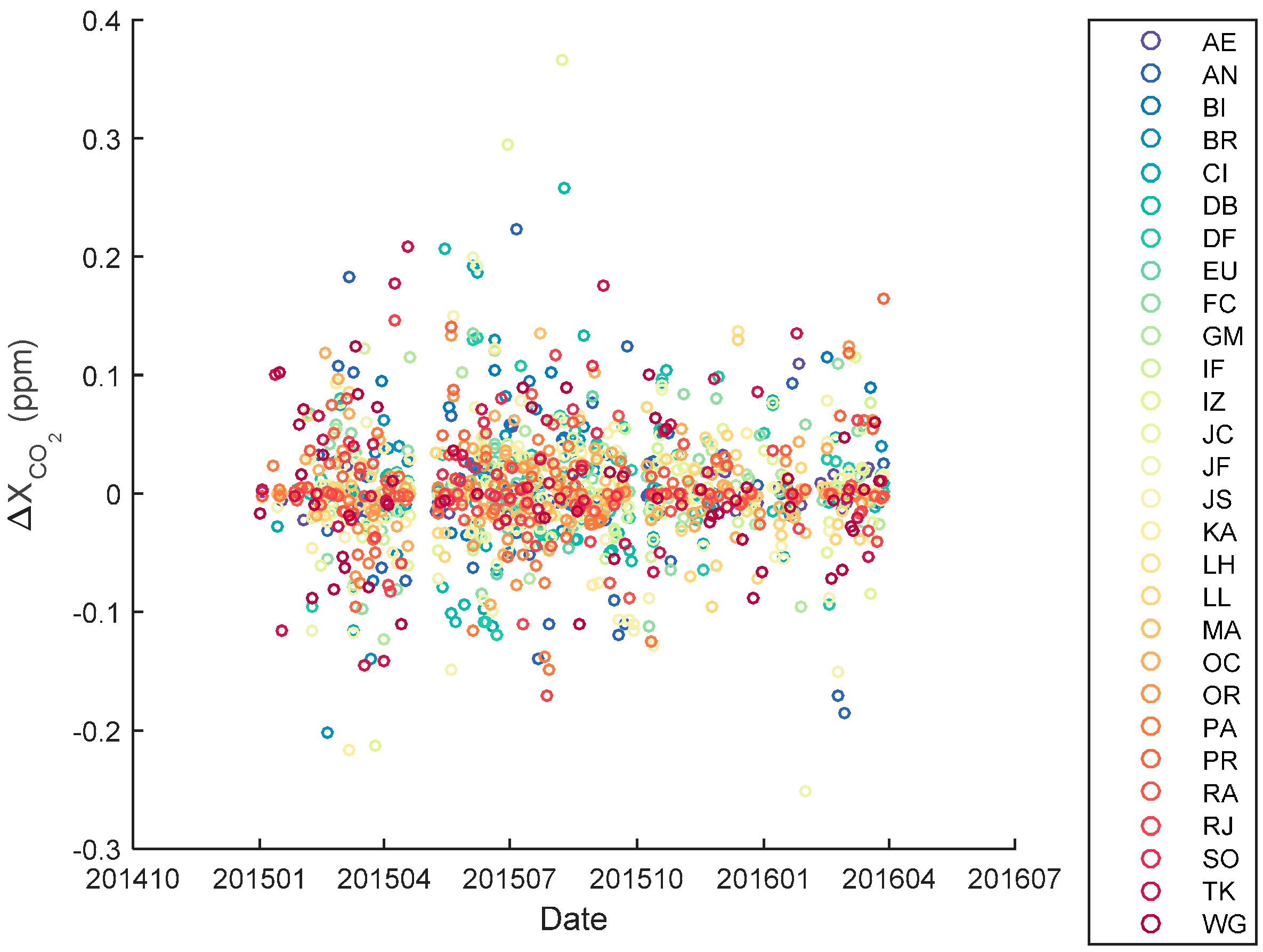
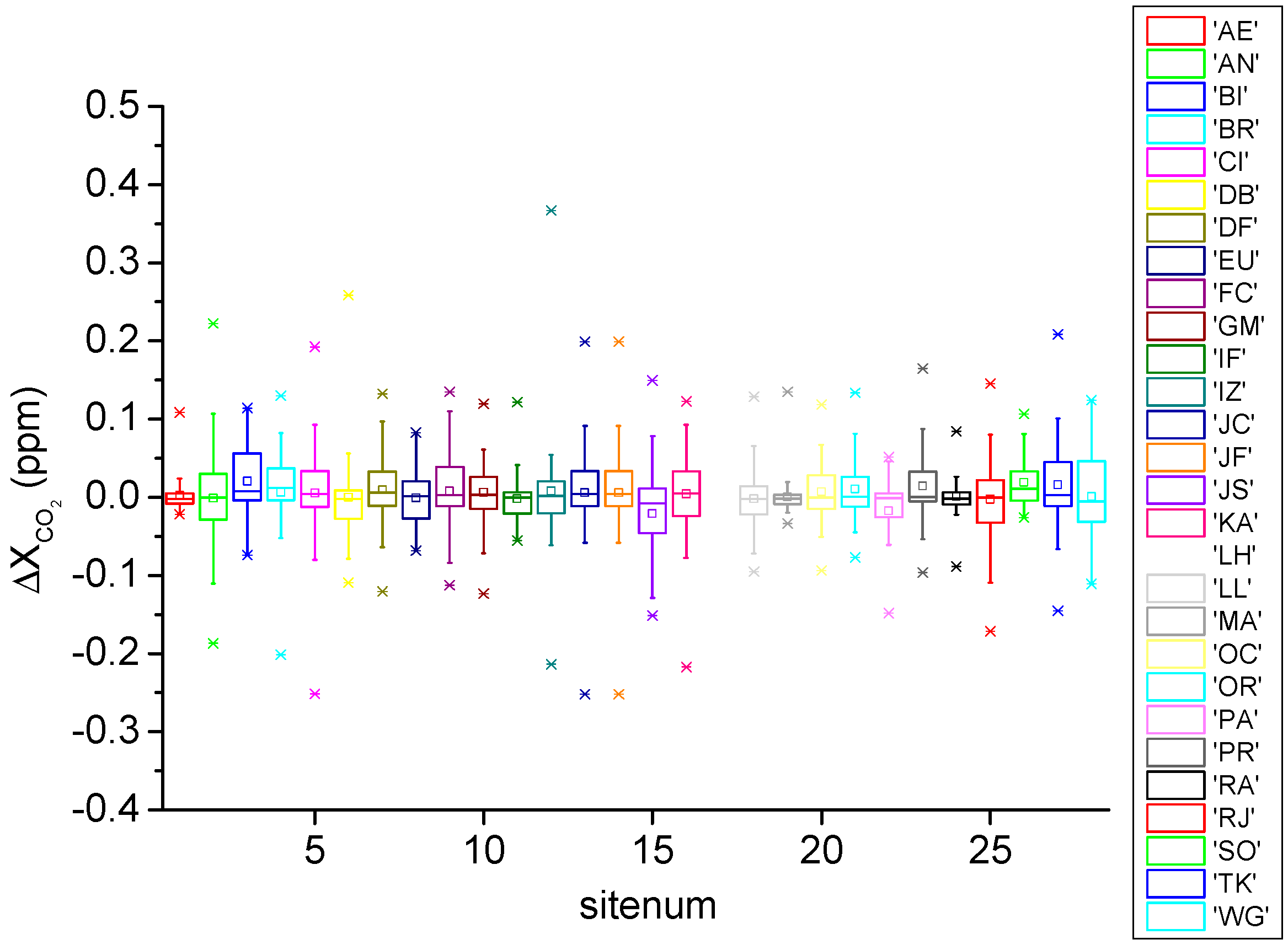
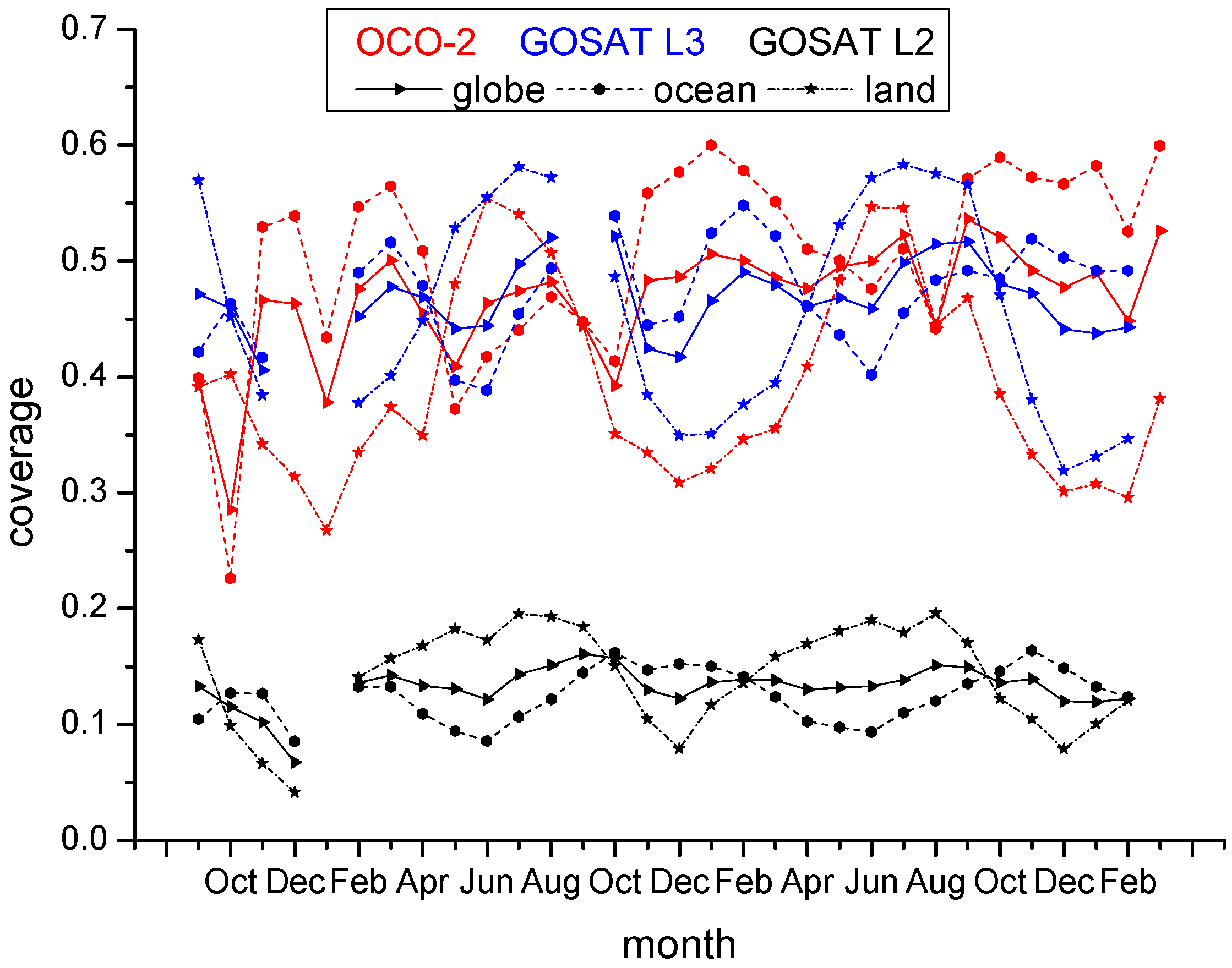
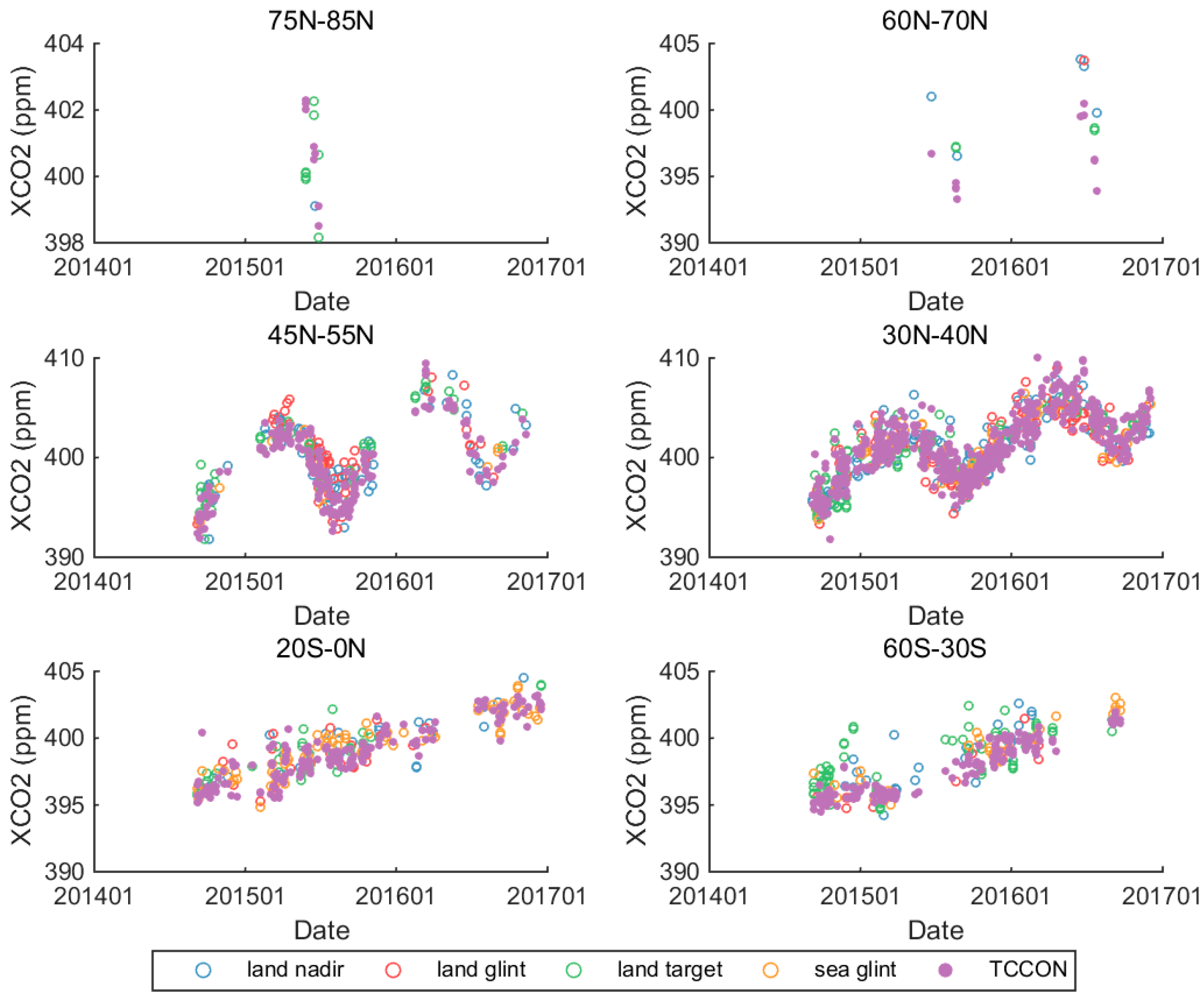
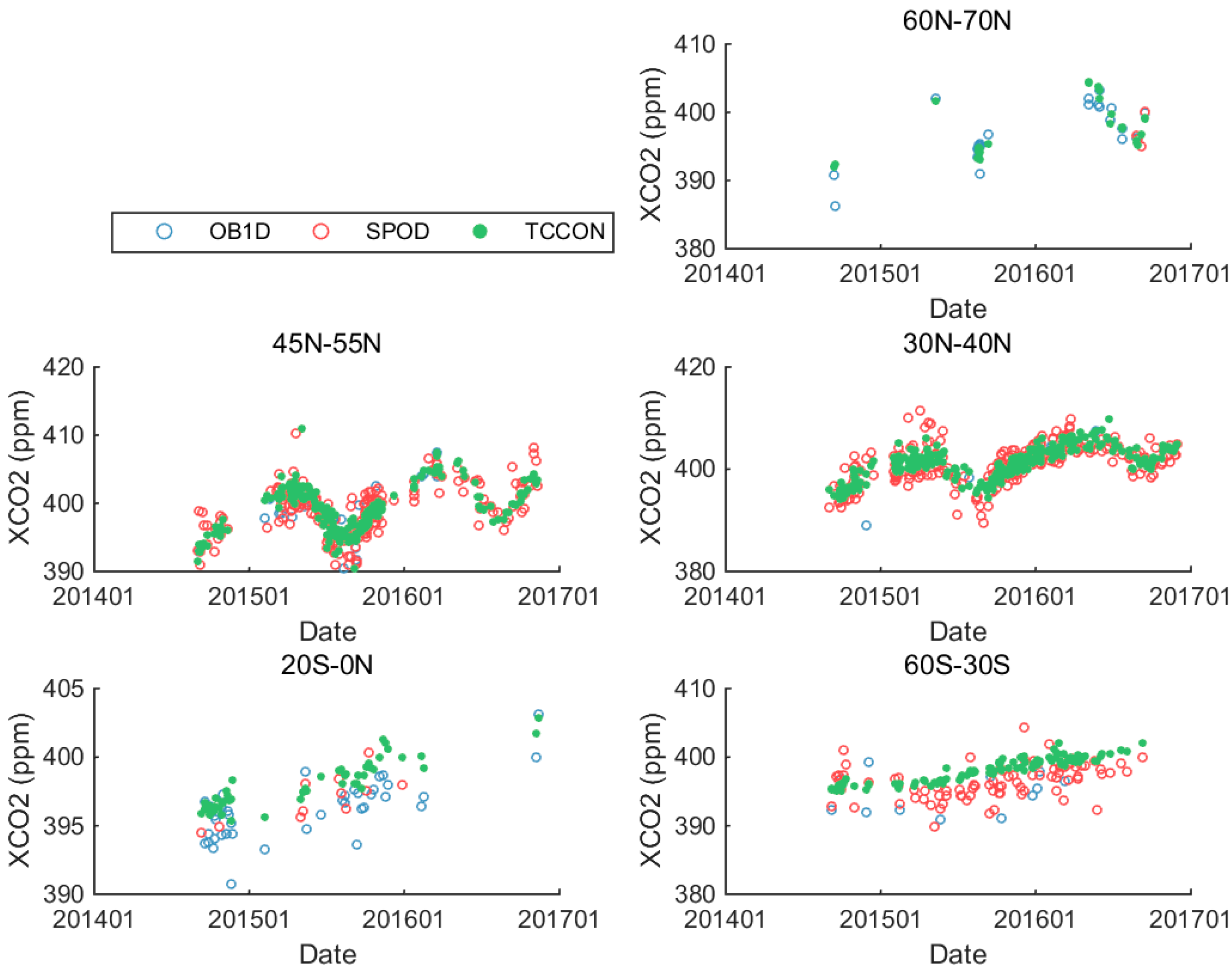
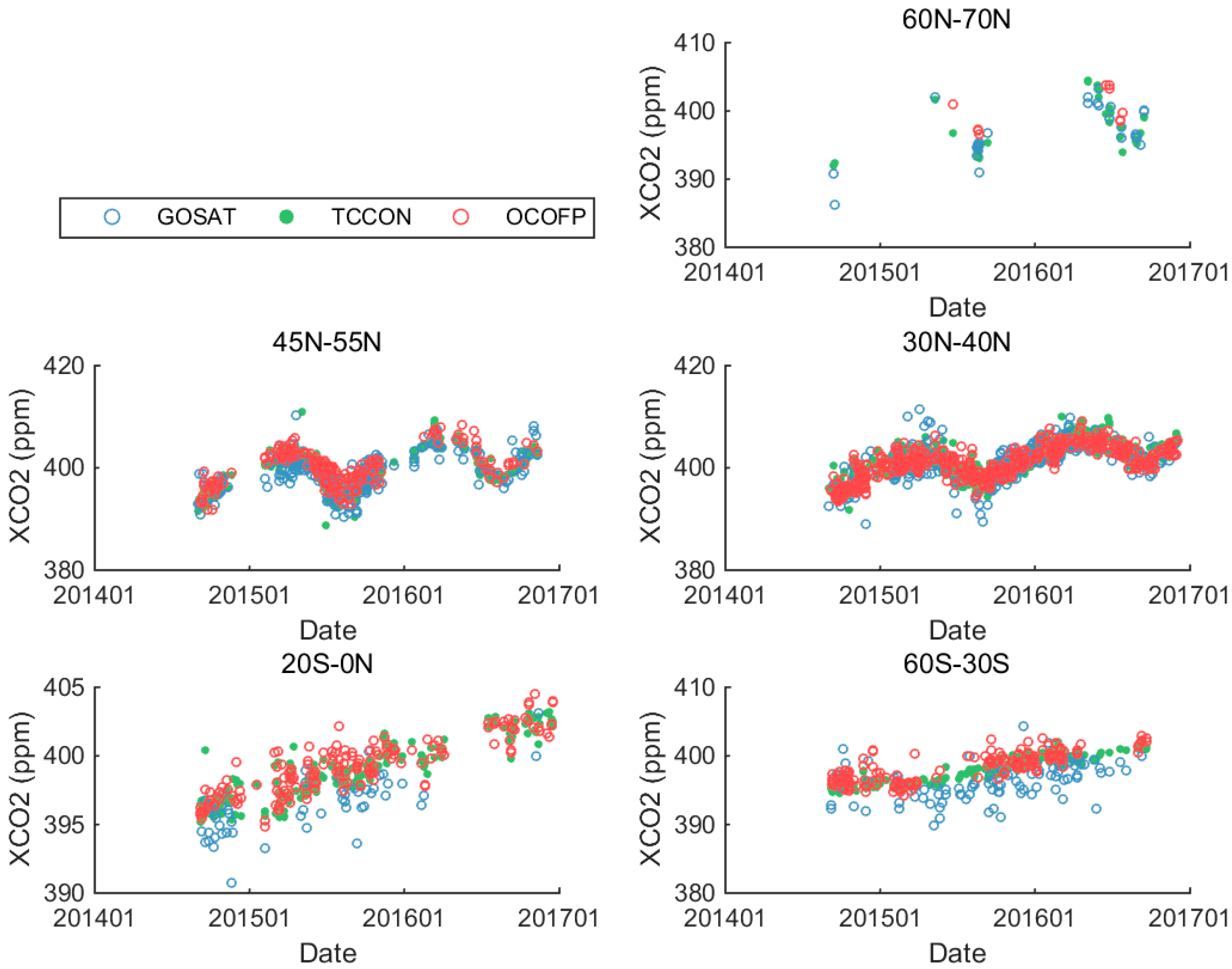
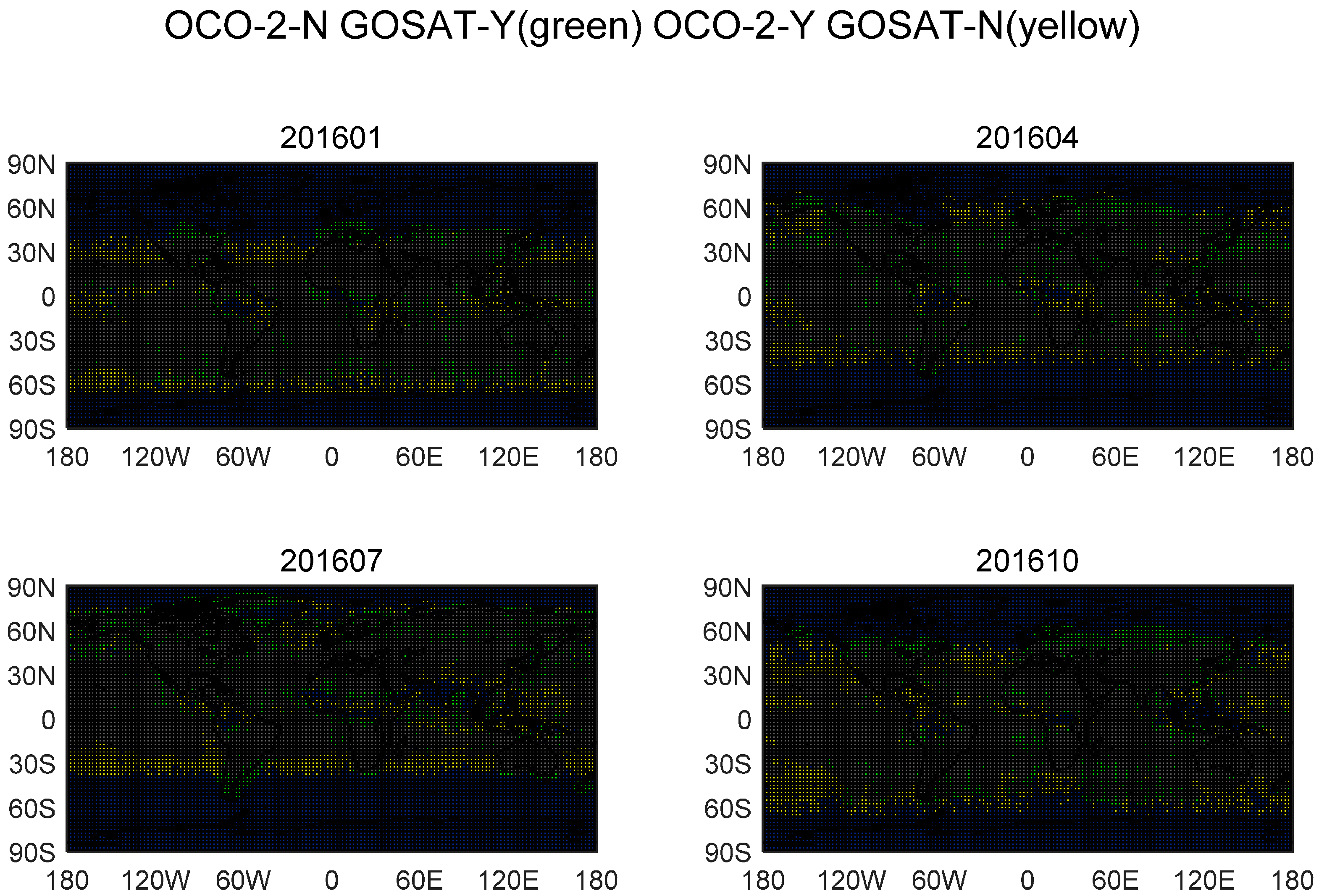
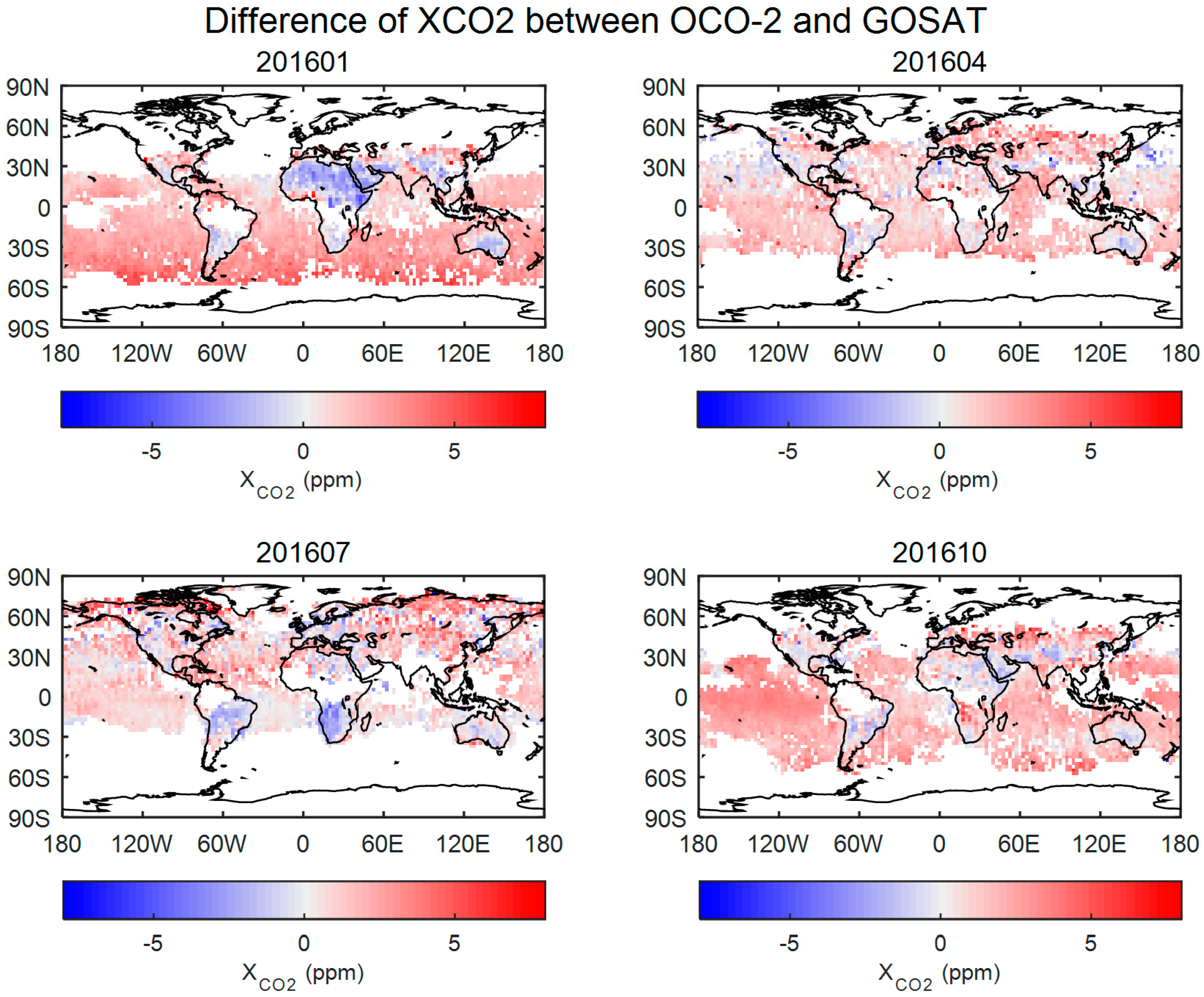

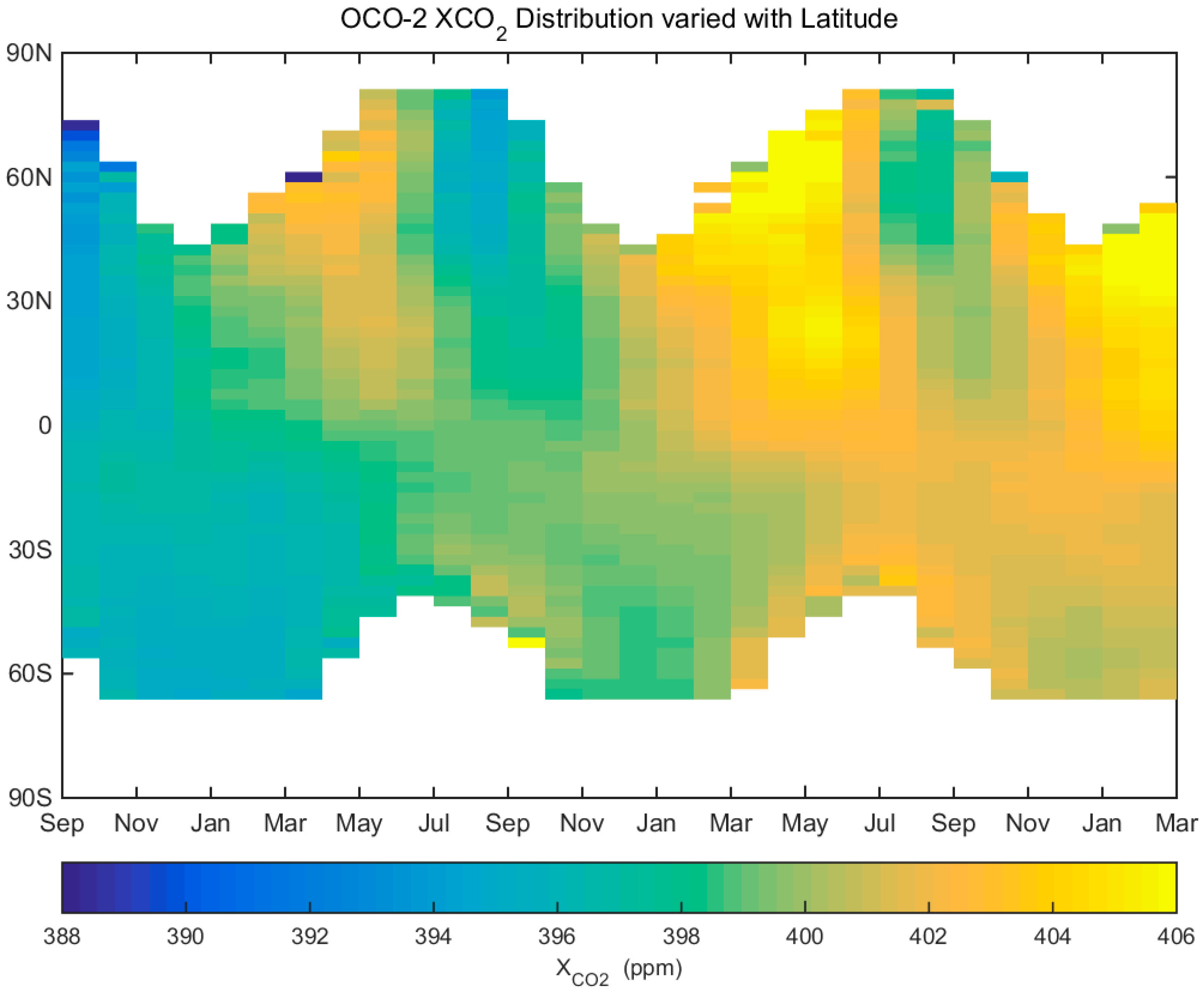
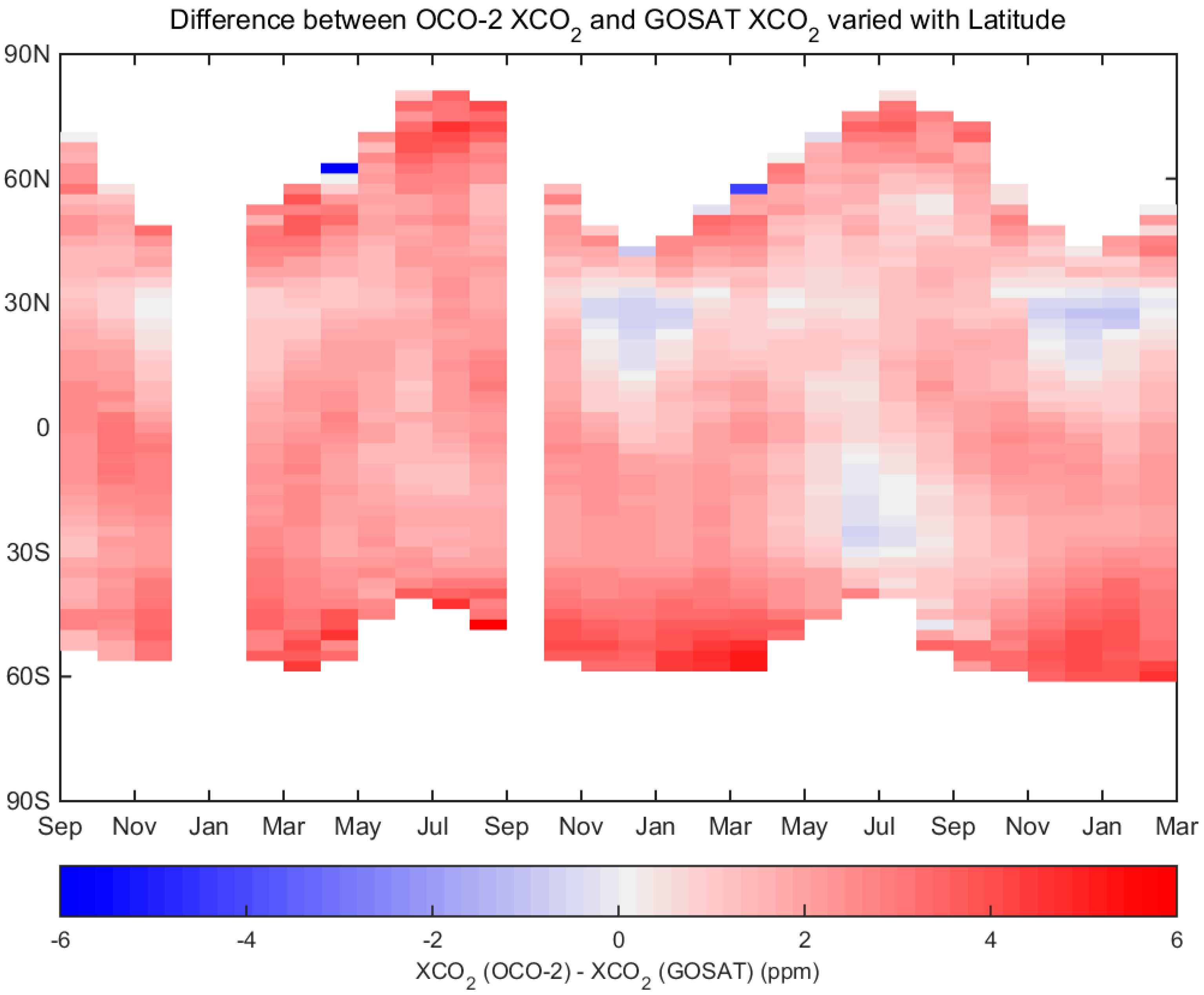

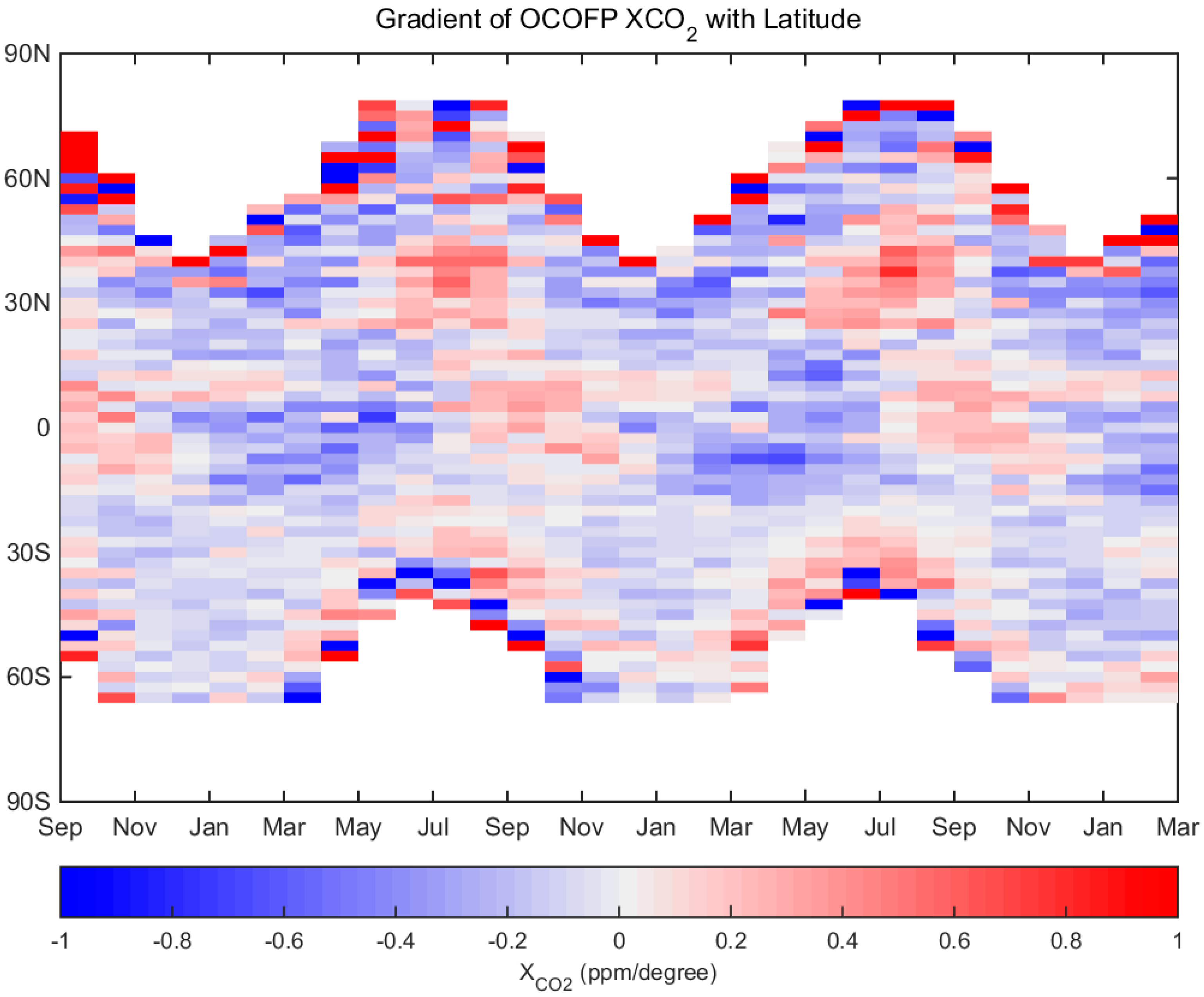


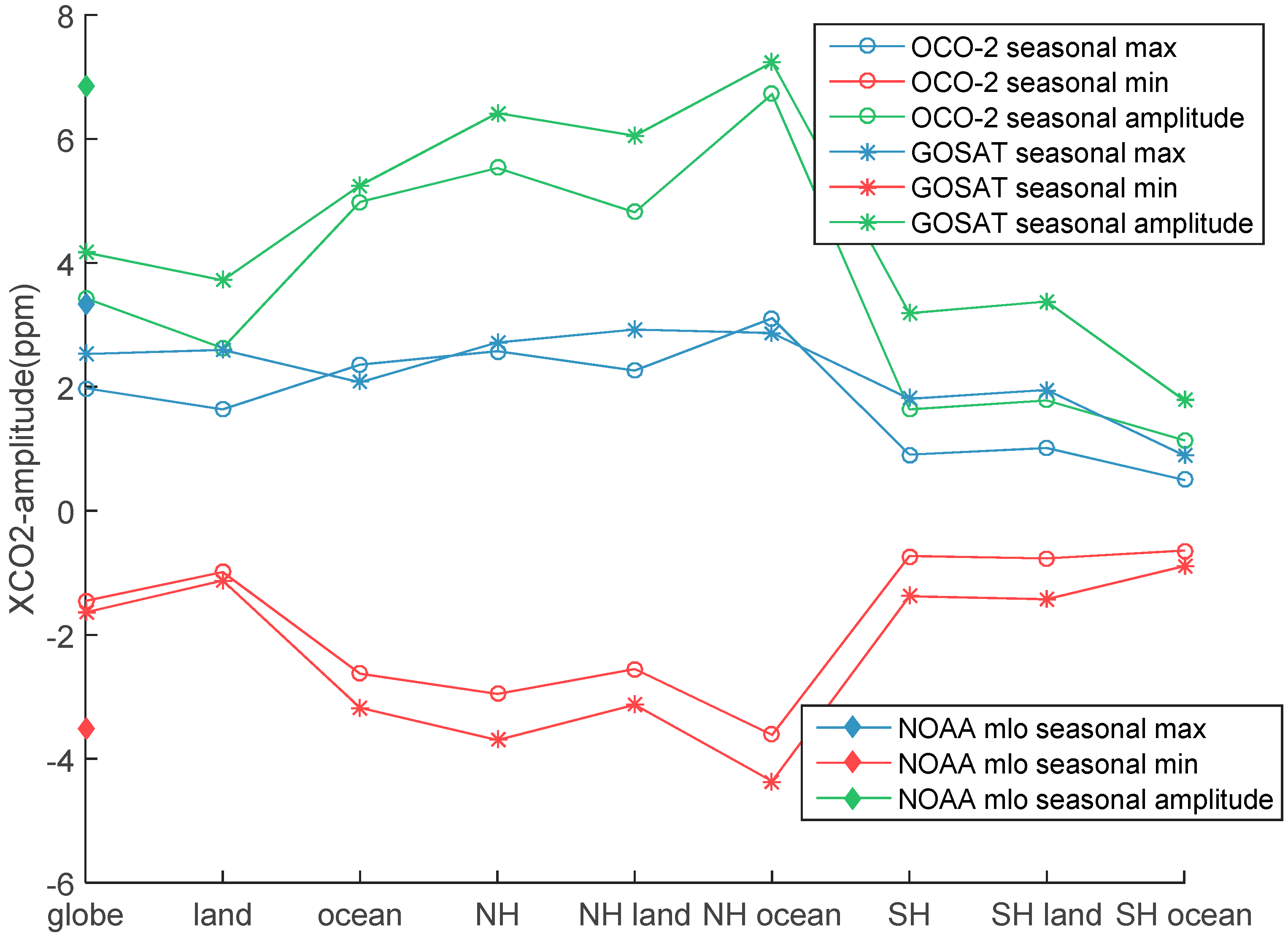
| OCO-2 | GOSAT | |
|---|---|---|
| Launch time | July 2014 | January 2009 |
| Orbit altitude | 705 km | 675 km |
| Spatial resolution | 1.29 km × 2.25 km | 10.5 km |
| Period | 98.8 min, 16 days/233 orbits | 98.1 min, 3 days/44 orbits |
| Equator crossing time | 1:36 pm | 1:00 pm |
| Site ID | Longitude | Latitude | Start Time | End Time | |
|---|---|---|---|---|---|
| AE [30] | Ascension Island, Saint Helena, Ascension and Tristan da Cunha | −14.33 | −7.92 | [2012, 5, 22] | [2016, 12, 21] |
| AN | Anmeyondo, South Korea | 126.33 | 36.54 | [2015, 2, 2] | [2015, 12, 8] |
| BI [31] | Bialystok, Poland | 23.02 | 53.23 | [2009, 3, 13] | [2016, 3, 30] |
| BR [32] | Bremen, Germany | 8.85 | 53.1 | [2007, 1, 15] | [2015, 12, 9] |
| CI [33] | California Institute of Technology, Pasadena, California, USA | −118.13 | 34.14 | [2012, 9, 20] | [2016, 12, 1] |
| DB [34] | Darwin, Australia | 130.89 | −12.43 | [2005, 8, 28] | [2016, 3, 30] |
| DF [35] | Armstrong Flight Research Center, Edwards, California, USA | −117.88 | 34.96 | [2013, 7, 20] | [2016, 8, 30] |
| EU [36] | Eureka, Canada | −86.42 | 80.05 | [2010, 3, 16] | [2016, 3, 29] |
| FC [37] | Four Corners, NM, USA | −108.48 | 36.8 | [2013, 3, 16] | [2013, 10, 4] |
| GM [38] | Garmisch, Germany | 11.06 | 47.48 | [2007, 7, 16] | [2016, 3, 29] |
| IF [39] | Indianapolis, Indiana, USA | −86 | 39.86 | [2012, 8, 23] | [2012, 12, 1] |
| IZ [40] | Izana, Tenerife, Spain | −16.48 | 28.3 | [2007, 5, 18] | [2016, 3, 18] |
| JC [41] | Jet Propulsion Laboratory, Pasadena, California, USA | −118.18 | 34.2 | [2007, 7, 31] | [2008, 6, 23] |
| JF [41] | Jet Propulsion Laboratory, Pasadena, California, USA | −118.18 | 34.2 | [2011, 5, 19] | [2013, 7, 1] |
| JS [42] | Saga, Japan | 130.29 | 33.24 | [2011, 7, 28] | [2016, 9, 27] |
| KA [43] | Karlsruhe, Germany | 8.44 | 49.1 | [2010, 4, 19] | [2016, 3, 22] |
| LH [44] | Lauder, New Zealand, 120HR | 169.68 | −45.05 | [2004, 6, 28] | [2010, 12, 8] |
| LL [44] | Lauder, New Zealand, 125HR | 169.68 | −45.04 | [2010, 2, 2] | [2016, 10, 1] |
| MA [45] | Manaus, Brazil | −60.6 | −3.21 | [2014, 10, 1] | [2015, 6, 24] |
| OC [46] | Lamont, Oklahoma, USA | −97.49 | 36.6 | [2008, 7, 6] | [2016, 12, 1] |
| OR [47] | Orleans, France | 2.11 | 47.97 | [2009, 8, 29] | [2016, 3, 29] |
| PA [48] | Park Falls, Wisconsin, USA | −90.27 | 45.94 | [2004, 6, 2] | [2016, 11, 26] |
| PR [49] | Paris, France | 2.36 | 48.85 | [2014, 9, 23] | [2016, 3, 22] |
| RA [50] | Reunion Island (Ile de La Reunion), France | 55.49 | −20.9 | [2011, 9, 16] | [2016, 12, 31] |
| RJ [51,52] | Rikubetsu, Hokkaido, Japan | 143.77 | 43.46 | [2013, 11, 16] | [2016, 3, 29] |
| SO [53,54] | Sodankyla, Finland | 26.63 | 67.37 | [2009, 5, 16] | [2016, 10, 22] |
| TK [52] | Tsukuba, Ibaraki, Japan, 125HR | 140.12 | 36.05 | [2011, 8, 4] | [2016, 3, 30] |
| WG [55] | Wollongong, Australia | 150.88 | −34.41 | [2008, 6, 25] | [2016, 3, 30] |
| OCO-2 | GOSAT | |||||||
|---|---|---|---|---|---|---|---|---|
| Volume | Land Nadir | Land Glint | Land Target | Sea Glint | OB1D (Since 2014) | SPOD (Since 2014) | OB1D (Since 2009) | SPOD (Since 2009) |
| 75°N–85°N | 3/1 | 0/0 | 226/8 | 0/0 | 0/0 | 0/0 | 3/1 | 0/0 |
| 60°N–70°N | 7/5 | 1/1 | 2002/5 | 0/0 | 53/23 | 4/4 | 205/89 | 6/6 |
| 45°N–55°N | 10,184/72 | 7855/59 | 27,525/51 | 1313/10 | 108/34 | 713/225 | 381/152 | 1545/569 |
| 30°N–40°N | 60,419/191 | 47,456/131 | 135,180/127 | 8580/69 | 18/7 | 805/267 | 239/94 | 2655/899 |
| 20°S–0° | 4093/26 | 4223/26 | 14,464/36 | 29,520/73 | 96/40 | 12/12 | 299/120 | 45/38 |
| 60°S–30°S | 2917/32 | 3334/16 | 28,948/76 | 8080/36 | 47/13 | 130/86 | 201/59 | 748/378 |
| ALL | 77,623/327 | 62,869/233 | 208,345/303 | 47,493/188 | 322/117 | 1664/594 | 1328/515 | 4999/1890 |
| OCO-2 | GOSAT | |||||||
|---|---|---|---|---|---|---|---|---|
| Site ID | Land Nadir | Land Glint | Land Target | Sea Glint | OB1D (Since 2014) | SPOD (Since 2014) | OB1D (Since 2009) | SPOD (Since 2009) |
| AE | 0/0 | 2/0 | 173/2 | 14,023/33 | 0/0 | 0/0 | 0/0 | 0/0 |
| AN | 421/8 | 200/0 | 0/0 | 1/1 | 1/0 | 30/12 | 1/0 | 30/12 |
| BI | 1287/11 | 654/6 | 5359/15 | 1/0 | 3/1 | 71/24 | 30/13 | 158/60 |
| BR | 577/2 | 95/4 | 0/0 | 404/1 | 2/1 | 7/3 | 7/4 | 66/23 |
| CI | 16,377/54 | 13,625/26 | 32,201/26 | 4143/22 | 4/3 | 25/24 | 13/6 | 134/105 |
| DB | 4044/19 | 4138/21 | 13,030/19 | 5274/6 | 90/35 | 11/11 | 289/113 | 42/35 |
| DF | 13,788/51 | 11,875/32 | 26,941/22 | 1601/15 | 3/2 | 17/16 | 12/5 | 84/62 |
| EU | 3/1 | 0/0 | 226/8 | 0/0 | 0/0 | 0/0 | 3/1 | 0/0 |
| FC | 0/0 | 0/0 | 0/0 | 0/0 | 0/0 | 0/0 | 7/3 | 6/2 |
| GM | 1519/11 | 1656/8 | 0/0 | 0/0 | 26/7 | 50/24 | 54/17 | 205/100 |
| IF | 0/0 | 0/0 | 0/0 | 0/0 | 0/0 | 0/0 | 54/15 | 20/9 |
| IZ | 3/1 | 43/0 | 0/0 | 450/1 | 0/0 | 0/0 | 3/2 | 20/10 |
| JC | 0/0 | 0/0 | 0/0 | 0/0 | 0/0 | 0/0 | 0/0 | 0/0 |
| JF | 0/0 | 0/0 | 0/0 | 0/0 | 0/0 | 0/0 | 114/48 | 20/19 |
| JS | 86/4 | 564/4 | 3367/3 | 1945/18 | 1/0 | 71/32 | 1/0 | 202/84 |
| KA | 1060/7 | 907/8 | 3159/7 | 1/0 | 0/0 | 61/26 | 12/2 | 174/84 |
| LH | 0/0 | 0/0 | 0/0 | 0/0 | 0/0 | 0/0 | 17/7 | 12/12 |
| LL | 727/13 | 1252/6 | 19,899/47 | 4530/25 | 44/12 | 78/55 | 159/44 | 155/131 |
| MA | 2/1 | 66/5 | 0/0 | 7/0 | 0/0 | 0/0 | 0/0 | 0/0 |
| OC | 29,224/62 | 20,874/69 | 61,310/58 | 7/0 | 9/2 | 474/128 | 34/15 | 1479/388 |
| OR | 2470/9 | 1338/7 | 7961/7 | 0/0 | 36/12 | 88/31 | 115/45 | 256/87 |
| PA | 2028/25 | 1669/18 | 10,556/18 | 275/5 | 4/2 | 315/76 | 118/58 | 544/170 |
| PR | 1096/4 | 1280/6 | 490/4 | 324/0 | 37/13 | 49/20 | 37/13 | 49/20 |
| RA | 47/6 | 17/0 | 1261/15 | 10,216/34 | 6/5 | 1/1 | 10/7 | 3/3 |
| RJ | 147/3 | 256/2 | 0/0 | 308/4 | 0/0 | 72/22 | 8/2 | 93/26 |
| SO | 7/5 | 1/1 | 2002/5 | 0/0 | 53/23 | 4/4 | 205/89 | 6/6 |
| TK | 520/11 | 275/0 | 11,361/18 | 433/12 | 0/0 | 188/55 | 0/0 | 660/208 |
| WG | 2190/19 | 2082/10 | 9049/29 | 3550/11 | 3/1 | 52/31 | 25/9 | 581/235 |
| Latitude Zone | Land Nadir | Land Glint | Land Target | Sea Glint | OCO-2 |
|---|---|---|---|---|---|
| 75°N–85°N | 0.0665(0.00317) | 0.0823(0.00546) | |||
| 60°N–70°N | 1.02(0.864) | 1.42(0.985) | 0.839(0.851) | ||
| 45°N–55°N | 0.84(0.822) | 0.844(0.731) | 1.07(0.896) | 1.04(0.874) | 0.923(0.815) |
| 30°N–40°N | 0.967(0.754) | 0.799(0.634) | 0.918(0.902) | 0.931(0.754) | 0.905(0.759) |
| 20°S–0° | 0.775(0.693) | 0.765(0.783) | 0.698(0.683) | 0.92(0.792) | 0.87(0.755) |
| 60°S–30°S | 0.716(0.713) | 0.772(0.722) | 0.727(0.602) | 0.875(0.861) | 0.759(0.692) |
| All | 0.947(0.758) | 0.855(0.701) | 0.982(0.84) | 0.977(0.795) | 0.937(0.773) |
| Latitude Zone | OB1D (Since 2014) | SPOD (Since 2014) | GOSAT (Since 2014) | OB1D (Since 2009) | SPOD (Since 2009) | GOSAT (Since 2009) |
|---|---|---|---|---|---|---|
| 75°N–85°N | ||||||
| 60°N–70°N | 0.887(0.82) | 0.597(0.628) | 0.876(0.809) | 0.947(0.918) | 0.845(0.943) | 0.945(0.92) |
| 45°N–55°N | 0.76(0.721) | 0.738(0.631) | 0.737(0.641) | 0.925(0.881) | 0.894(0.849) | 0.902(0.866) |
| 30°N–40°N | 0.459(0.507) | 0.637(0.592) | 0.629(0.585) | 0.726(0.776) | 0.83(0.811) | 0.815(0.816) |
| 20°S–0° | 0.646(0.576) | 0.808(0.722) | 0.619(0.554) | 0.911(0.873) | 0.802(0.901) | 0.865(0.863) |
| 60°S–30°S | 0.19(0.067) | 0.34(0.23) | 0.316(0.21) | 0.943(0.798) | 0.892(0.793) | 0.897(0.793) |
| All | 0.657(0.626) | 0.676(0.635) | 0.67(0.649) | 0.904(0.855) | 0.859(0.84) | 0.865(0.851) |
| OCO-2 | GOSAT | |||||||
|---|---|---|---|---|---|---|---|---|
| Site ID | Land Nadir | Land Glint | Land Target | Sea Glint | OB1D (Since 2014) | SPOD (Since 2014) | OB1D (Since 2009) | SPOD (Since 2009) |
| AE | 0.842(0.723) | |||||||
| AN | 0.827(0.92) | 0.657(0.677) | 0.657(0.677) | |||||
| BI | 0.931(0.803) | 1.37(0.717) | 1.21(0.834) | 0.719(0.474) | 0.958(0.876) | 0.92(0.805) | ||
| BR | 0.591(0.767) | 1.11(0.883) | 0.775(0.891) | |||||
| CI | 0.962(0.73) | 0.878(0.567) | 0.77(0.882) | 0.915(0.611) | 0.691(0.405) | 0.671(0.941) | 0.87(0.773) | |
| DB | 0.774(0.595) | 0.832(0.838) | 0.644(0.509) | 0.973(0.911) | 0.58(0.397) | 0.774(0.801) | 0.905(0.872) | 0.837(0.933) |
| DF | 0.81(0.806) | 0.683(0.636) | 0.968(0.937) | 0.863(0.775) | 0.365(0.494) | 0.708(0.947) | 0.519(0.7) | |
| EU | 0.0665(0.00317) | |||||||
| FC | ||||||||
| GM | 0.724(0.7) | 0.822(0.9) | 0.763(0.776) | 0.735(0.695) | 0.851(0.837) | 0.84(0.811) | ||
| IF | 0.593(0.47) | 0.614(0.71) | ||||||
| IZ | 1.13(0.912) | |||||||
| JC | ||||||||
| JF | 0.487(0.457) | 0.571(0.628) | ||||||
| JS | 0.949(0.986) | 0.992(0.915) | 0.952(0.912) | 0.93(0.691) | 0.851(0.761) | |||
| KA | 0.804(0.773) | 1.06(0.827) | 0.868(0.934) | 0.721(0.561) | 0.884(0.818) | |||
| LH | 0.691(0.524) | 0.918(0.503) | ||||||
| LL | 0.364(0.368) | 0.747(0.908) | 0.735(0.684) | 0.847(0.942) | 0.182(0.0583) | 0.434(0.374) | 0.961(0.751) | 0.958(0.876) |
| MA | 0.317(0.387) | |||||||
| OC | 1.07(0.885) | 0.818(0.765) | 0.99(0.883) | 0.763(0.782) | 0.945(0.856) | 0.941(0.918) | ||
| OR | 0.89(0.721) | 0.715(0.896) | 0.991(0.981) | 0.788(0.874) | 0.848(0.809) | 0.921(0.94) | 0.946(0.894) | |
| PA | 0.768(0.908) | 0.771(0.902) | 0.924(0.936) | 1.11(0.915) | 0.753(0.657) | 0.74(0.79) | 0.919(0.883) | |
| PR | 0.977(0.978) | 0.779(0.284) | 1.57(0.848) | 0.803(0.804) | 0.694(0.584) | 0.803(0.804) | 0.694(0.584) | |
| RA | 0.583(0.357) | 0.862(0.817) | 1.03(0.843) | 0.622(0.933) | 0.744(0.888) | |||
| RJ | 1.02(0.873) | 0.704(0.706) | 0.721(0.773) | |||||
| SO | 1.02(0.864) | 1.42(0.985) | 0.887(0.82) | 0.597(0.628) | 0.947(0.918) | 0.845(0.943) | ||
| TK | 0.952(0.53) | 0.876(0.944) | 0.763(0.877) | 0.653(0.599) | 0.942(0.809) | |||
| WG | 0.787(0.831) | 0.785(0.701) | 0.774(0.555) | 1.18(0.588) | 0.201(0.081) | 1.07(0.911) | 0.83(0.693) | |
| OCO−2 | GOSAT | |||||||
|---|---|---|---|---|---|---|---|---|
| Site ID | Land Nadir | Land Glint | Land Target | Sea Glint | OB1D (Since 2014) | SPOD (Since 2014) | OB1D (Since 2009) | SPOD (Since 2009) |
| AE | - | - | 0.3122 ± 0.6173 | −0.2081 ± 1.054 | - | - | - | - |
| AN | 2.205 ± 0.9559 | - | - | 1.254 ± 0 | - | 0.06877 ± 1.873 | - | 0.06877 ± 1.873 |
| BI | 1.069 ± 0.9757 | 3.835 ± 3.269 | 1.622 ± 1.723 | - | 2.112 ± 0 | −0.2381 ± 2.109 | 0.2359 ± 1.865 | 0.01919 ± 1.927 |
| BR | 1.728 ± 0.5042 | 0.9189 ± 0.8093 | - | −0.0171 ± 0 | 1.024 ± 0 | 1.36 ± 3.02 | 0.5418 ± 2.735 | 0.2102 ± 2.079 |
| CI | −1.339 ± 1.583 | −1.3 ± 2.363 | −0.006131 ± 1.019 | −1.311 ± 1.885 | 0.4945 ± 1.427 | −0.345 ± 2.186 | −0.6119 ± 1.773 | −0.1519 ± 2.037 |
| DB | 0.4452 ± 1.077 | 0.2 ± 0.7112 | 0.2301 ± 0.8956 | −0.4211 ± 0.7246 | −1.724 ± 1.352 | −0.9812 ± 1.039 | −1.305 ± 1.479 | −0.4357 ± 1.492 |
| DF | 0.5121 ± 1.248 | 0.8969 ± 1.923 | −0.9662 ± 0.7063 | 0.4714 ± 1.338 | 2.339 ± 0.7834 | 3.909 ± 3.474 | 1.345 ± 1.174 | 1.459 ± 2.908 |
| EU | −1.582 ± 0 | - | −0.5762 ± 1.906 | - | - | - | −2.085 ± 0 | - |
| FC | - | - | - | - | - | - | −1.068 ± 0.6567 | −0.9305 ± 0.2116 |
| GM | 0.3139 ± 2.207 | 1.321 ± 0.9766 | - | - | 0.7737 ± 1.775 | −0.04457 ± 1.77 | 0.2142 ± 2.193 | 0.03482 ± 2.359 |
| IF | - | - | - | - | - | - | −0.6978 ± 1.91 | 0.3259 ± 1.388 |
| IZ | 0.07387 ± 0 | - | - | −0.7374 ± 0 | - | - | −1.687 ± 0.3916 | −1.641 ± 1.148 |
| JC | - | - | - | - | - | - | - | - |
| JF | - | - | - | - | - | - | −1.969 ± 2.401 | 1.891 ± 1.737 |
| JS | 0.579 ± 0.6802 | −1.391 ± 0.6425 | −1.302 ± 0.6986 | −0.5398 ± 1.021 | - | 0.6149 ± 2.158 | - | 0.5001 ± 2.212 |
| KA | 1.625 ± 0.8358 | 2.277 ± 1.056 | 1.019 ± 1.051 | - | - | 0.4475 ± 2.193 | 0.8617 ± 0.8142 | 0.6267 ± 2.076 |
| LH | - | - | - | - | - | - | −2.313 ± 1.473 | −2.051 ± 1.422 |
| LL | 0.9835 ± 1.48 | 0.1363 ± 0.6523 | 0.4665 ± 1.224 | 0.4967 ± 0.6683 | −2.473 ± 2.987 | −1.82 ± 1.925 | −0.906 ± 2.162 | −1.156 ± 1.713 |
| MA | 0.9727 ± 0 | 0.4654 ± 1.161 | - | - | - | - | - | - |
| OC | −0.09046 ± 1.173 | 0.1603 ± 1.409 | −0.3063 ± 1.043 | - | −4.841 ± 4.542 | −1.271 ± 1.632 | −2.625 ± 1.995 | −1.421 ± 1.584 |
| OR | 1.16 ± 1.855 | 1.883 ± 1.219 | 0.4393 ± 0.4621 | - | −1.605 ± 1.274 | −0.5296 ± 1.466 | −1.251 ± 1.699 | −0.51 ± 1.762 |
| PA | 0.6062 ± 1.259 | 0.6962 ± 1.435 | 0.5534 ± 0.971 | 1.078 ± 1.162 | −1.047 ± 5.617 | −0.5276 ± 2.273 | 0.03045 ± 2.412 | −0.3444 ± 2.166 |
| PR | 0.643 ± 0.6813 | −0.8429 ± 1.423 | −1.639 ± 0.2435 | - | −2.206 ± 1.959 | −1.659 ± 2.011 | −2.206 ± 1.959 | −1.659 ± 2.011 |
| RA | 0.9441 ± 1.463 | - | 1.505 ± 0.9771 | 0.3255 ± 0.9726 | −2.47 ± 1.898 | −2.038 ± 0 | −2.438 ± 1.676 | 2.42 ± 3.912 |
| RJ | 0.5894 ± 0.578 | 2.715 ± 0.5235 | - | 0.1922 ± 1.336 | - | 0.7925 ± 2.164 | −0.6846 ± 0.09038 | 0.5172 ± 2.177 |
| SO | 4.119 ± 1.189 | 4.136 ± 0 | 2.664 ± 0.3484 | - | −0.5228 ± 1.83 | 0.2718 ± 1.355 | 0.006901 ± 1.79 | −0.03789 ± 1.17 |
| TK | 0.9581 ± 1.931 | - | 0.5089 ± 0.7652 | −0.3152 ± 1.172 | - | 0.5685 ± 1.896 | - | 1.488 ± 2.098 |
| WG | 0.5702 ± 1.009 | −0.5041 ± 1.273 | 1.374 ± 1.26 | 0.7546 ± 1.125 | −1.229 ± 0 | −1.676 ± 2.845 | −2.122 ± 1.798 | −0.7749 ± 2.292 |
| ALL | 0.2951 ± 1.627 | 0.3795 ± 1.873 | 0.3368 ± 1.345 | −0.03313 ± 1.288 | −1.335 ± 2.162 | −0.4792 ± 2.302 | −0.8862 ± 2.073 | −0.2812 ± 2.237 |
| OCO-2 | GOSAT (2014) | GOSAT (2009) | |
|---|---|---|---|
| Accuracy (ppm) | 0.2671 ± 1.56 | −0.62 ± 2.3 | −0.4107 ± 2.216 |
| Accuracy (%) | 0.06797 ± 0.3903 | −0.1549 ± 0.5753 | −0.1038 ± 0.5615 |
© 2017 by the authors. Licensee MDPI, Basel, Switzerland. This article is an open access article distributed under the terms and conditions of the Creative Commons Attribution (CC BY) license (http://creativecommons.org/licenses/by/4.0/).
Share and Cite
Liang, A.; Gong, W.; Han, G.; Xiang, C. Comparison of Satellite-Observed XCO2 from GOSAT, OCO-2, and Ground-Based TCCON. Remote Sens. 2017, 9, 1033. https://doi.org/10.3390/rs9101033
Liang A, Gong W, Han G, Xiang C. Comparison of Satellite-Observed XCO2 from GOSAT, OCO-2, and Ground-Based TCCON. Remote Sensing. 2017; 9(10):1033. https://doi.org/10.3390/rs9101033
Chicago/Turabian StyleLiang, Ailin, Wei Gong, Ge Han, and Chengzhi Xiang. 2017. "Comparison of Satellite-Observed XCO2 from GOSAT, OCO-2, and Ground-Based TCCON" Remote Sensing 9, no. 10: 1033. https://doi.org/10.3390/rs9101033





